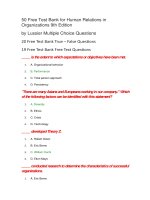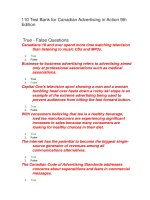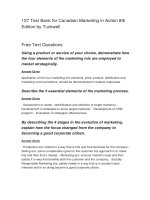Test bank for patient care in radiography 9th edition by ehrlich
Bạn đang xem bản rút gọn của tài liệu. Xem và tải ngay bản đầy đủ của tài liệu tại đây (51.92 KB, 3 trang )
Chapter 01: Introduction to Radiography
Ehrlich: Patient Care in Radiography: With an Introduction to Medical Imaging, 9th Edition
MULTIPLE CHOICE
1. X-rays were discovered in 1895 by:
a. Coolidge.
b. Crookes.
c. Roentgen.
d. Edison.
ANS: C
REF: p. 2
OBJ: 1
2. Of the following types of electromagnetic energy, which has the shortest wavelength?
a. Radio waves
b. X-rays
c. Visible light
d. Ultraviolet light
ANS: B
REF: p. 7
OBJ: 7
3. Which of the following is NOT an accurate statement regarding the characteristics of x-rays?
a. They can penetrate matter that is impenetrable to light.
b. They cause certain crystals to fluoresce.
c. They can be refracted by a lens.
d. They cannot be detected by the human senses.
ANS: C
REF: pp. 7-8
OBJ: 8
surrounding
hot Patient
cathode isCare
referred
to as a(n):
4. An electron cloud Test
Bankafor
in Radiography
a. focusing cup.
b. ampere.
Full file at />c. space charge.
d. filament.
ANS: C
REF: p. 6
9th Edition by Ehrlich
OBJ: 6
5. The purpose of rotating the x-ray tube target is to:
a. create a space charge.
b. remove long-wavelength photons from the x-ray beam.
c. focus the electron stream on a small target area.
d. increase the heat capacity of the anode.
ANS: D
REF: p. 9
OBJ: 6
6. An imaginary photon that is emitted from the center of the focal spot, perpendicular to the long axis of the x-ray tube, is called the:
a. electron stream.
b. x-ray beam.
c. central ray.
d. radiation field.
ANS: C
REF: p. 8
OBJ: 10
7. A device used to control the size of the radiation field is a:
a. collimator.
b. detent.
c. tube housing.
d. filter.
ANS: A
REF: p. 8
OBJ: 11
8. The function of an x-ray grid is to:
a. decrease patient radiation dose.
b. increase radiographic resolution.
c. increase radiographic contrast by reducing scatter radiation fog.
d. increase radiographic density.
ANS: C
REF: p. 14
OBJ: 11
9. The majority of radiography education programs today are based in:
a. proprietary schools.
b. hospitals.
c. clinics.
d. colleges.
ANS: D
REF: p. 4
OBJ: 3
Copyright © 2017, Elsevier Inc. All Rights Reserved.
Full file at />
1
10. The container for the vacuum of the x-ray tube is made of:
a. glass.
b. aluminum.
c. tungsten.
d. carbon.
ANS: A
REF: p. 5
OBJ: 4
11. X-rays are a type of:
a. electricity.
b. microwave.
c. kinetic energy.
d. electromagnetic energy.
ANS: D
REF: p. 6
OBJ: 7
12. The frequency of an electromagnetic sine wave is defined as:
a. the distance from trough to crest.
b. the distance from one crest to the next.
c. the number of times per second that a crest passes a given point.
d. the velocity at which the wave travels through space.
ANS: C
REF: p. 6
OBJ: 9
13. Which of the following formulas represents the relationship between the wavelength, frequency, and velocity of an electromagnetic
wave?
a. f = λ × v
b. V = λ × f
c. Λ = f ÷ v
d. f = λ ÷ v
ANS: B
Test
Bank for Patient
Care in Radiography 9th Edition by Ehrlich
REF: p. 6
OBJ: 9
Full
file at />substances
is most readily penetrated by x-rays?
14. Which of the following
a. Water
b. Air
c. Bone
d. Fat
ANS: B
REF: p. 7
OBJ: 8
15. Grids or buckys are generally used for body parts that measure greater than:
a. 2 to 4 cm.
b. 10 to 12 cm.
c. 18 to 20 cm.
d. 30 cm.
ANS: B
REF: p. 15
OBJ: 11
16. The access point for the radiographer to determine the exposure factors and to initiate the exposure is called the:
a. transformer.
b. image receptor unit.
c. control console.
d. stationary grid.
ANS: C
REF: p. 16
OBJ: 11
17. An x-ray machine designed for direct viewing of the x-ray image is called a(n):
a. image receptor.
b. transformer.
c. control console.
d. fluoroscope.
ANS: D
REF: p. 17
OBJ: 11
18. A device located between the x-ray tube and the control panel that increases the voltage delivered from the power company is
called a:
a. collimator.
b. transformer.
c. control console.
d. fluoroscope.
ANS: B
REF: p. 16
OBJ: 11
19. The anode or positive end of the x-ray tube is the end that contains the:
a. target.
b. filament.
c. focusing cup.
d. space charge.
ANS: A
REF: p. 6
OBJ: 5
Copyright © 2017, Elsevier Inc. All Rights Reserved.
Full file at />
2
20. The inventor of the fluoroscope, who also investigated hundreds of fluorescent materials, was:
a. Coolidge.
b. Pupin.
c. Roentgen.
d. Edison.
ANS: D
REF: p. 3
OBJ: 2
21. The inventor of the hot cathode x-ray tube, the prototype of the x-ray tubes of today, was:
a. Coolidge.
b. Pupin.
c. Roentgen.
d. Edison.
ANS: A
REF: p. 3
OBJ: 2
Test Bank for Patient Care in Radiography 9th Edition by Ehrlich
Full file at />
Copyright © 2017, Elsevier Inc. All Rights Reserved.
Full file at />
3









